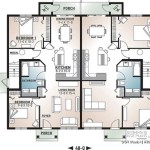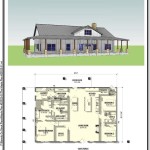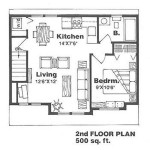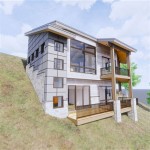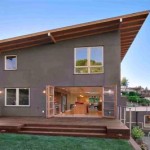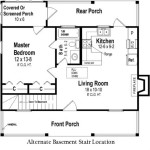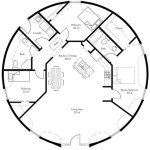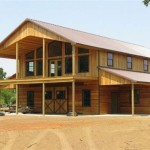1,000 Square Foot House Plans: Maximizing Space and Functionality
Designing a home within a 1,000 square foot footprint requires careful planning and strategic considerations. These smaller homes offer affordability, simplified maintenance, and reduced environmental impact. However, optimizing every square inch is crucial to ensure comfortable living and efficient use of space. This article explores key factors involved in developing effective 1,000 square foot house plans, focusing on design principles, layout options, and storage solutions.
Prioritizing Needs and Lifestyle
Before embarking on the design process, homeowners should thoroughly assess their needs and lifestyle. This involves identifying the number of occupants, their individual requirements, and the anticipated frequency of hosting guests. Defining priorities, such as a large kitchen, a dedicated home office, or ample outdoor space, will guide design decisions and ensure the final plan aligns with the homeowner's specific circumstances.
Consideration should be given to long-term flexibility. A young couple might prioritize open-concept living, while a family with children may require more distinct zones for privacy and quiet activities. Anticipating future needs, such as aging in place, can also influence design choices, including incorporating wider doorways, accessible bathrooms, and single-level layouts.
Furthermore, it is essential to evaluate existing possessions and realistically estimate storage needs. This prevents overcrowding and ensures a clutter-free living environment. Utilizing vertical space, multi-functional furniture, and innovative storage solutions becomes critical when designing within a limited footprint.
Optimizing Layout and Space Allocation
The layout of a 1,000 square foot house plan significantly impacts its overall functionality and perceived spaciousness. Open-concept designs are popular choices, as they create a sense of flow and maximize natural light. Combining living, dining, and kitchen areas into a single, unified space can make the home feel larger than its actual size.
However, open-concept layouts require careful zoning to define distinct areas within the shared space. This can be achieved through the use of furniture arrangements, area rugs, varying ceiling heights, and strategically placed partitions. Maintaining visual consistency in materials and color palettes contributes to a cohesive and harmonious design.
Alternative layouts include compartmentalized designs, which offer greater privacy and separation between rooms. This approach is often preferred by individuals who value quiet and solitude. However, it can also make the home feel smaller and more confined. Carefully considering the pros and cons of each layout style is essential to determine the most suitable option for individual preferences and lifestyle.
Regardless of the chosen layout, efficient circulation is crucial. Hallways should be minimized to avoid wasted space, and rooms should be strategically positioned to ensure easy accessibility and flow. Utilizing every corner and nook, such as turning under-stair space into storage, can maximize the usable area within the home.
Furthermore, the orientation of the house on the lot can significantly impact the amount of natural light and ventilation. Orienting living spaces towards the south can maximize sunlight exposure during winter months, while providing shading on the west-facing side can minimize heat gain during summer. Proper ventilation can reduce the need for air conditioning, contributing to energy efficiency and cost savings.
Implementing Smart Storage Solutions
Storage is paramount in a small house. Creative and efficient storage solutions are vital for maximizing space and maintaining a clutter-free environment. Multi-functional furniture, such as sofa beds, storage ottomans, and coffee tables with built-in drawers, offers dual utility and minimizes the need for separate storage units.
Vertical space should be fully utilized through the incorporation of tall shelving units, wall-mounted cabinets, and lofted storage areas. Kitchen cabinets can extend to the ceiling to maximize storage capacity, and shelves can be installed above doorways and windows to create additional storage space. Utilizing space under beds and stairs provides discreet and accessible storage options.
Built-in storage solutions, such as custom-designed closets and drawers, can be tailored to specific needs and maximize space utilization. These built-ins can be integrated seamlessly into the design of the home, creating a cohesive and aesthetically pleasing look. Furthermore, incorporating organizational systems, such as drawer dividers, shelf organizers, and hanging racks, can help keep belongings neatly stored and easily accessible.
Consider the specific storage needs of each room. The kitchen benefits from organized pantries, spice racks, and utensil holders. Bathrooms require storage for toiletries, towels, and cleaning supplies. Bedrooms need ample closet space for clothing, shoes, and accessories. Tailoring storage solutions to the specific needs of each room ensures efficient use of space and a clutter-free living environment.
Outdoor storage solutions, such as sheds, decks with built-in storage, and weatherproof cabinets, can also enhance functionality. These storage options provide space for gardening tools, outdoor equipment, and seasonal items, freeing up valuable space inside the home.
Careful planning and thoughtful design can transform a 1,000 square foot house into a comfortable, functional, and aesthetically pleasing living space. Prioritizing needs, optimizing layout, and implementing smart storage solutions are essential for maximizing space and creating a home that meets the homeowner's specific requirements and lifestyle.
Choosing the right materials and finishes can also significantly impact the perceived size and ambiance of the home. Light and neutral color palettes can create a sense of spaciousness and airiness, while dark colors can make a room feel smaller and more enclosed. Mirrors can be strategically placed to reflect light and create the illusion of more space. Using consistent flooring throughout the home can also create a visual flow and make the space feel larger.
Natural light plays a crucial role in creating a welcoming and comfortable living environment. Maximizing natural light through large windows, skylights, and strategically placed mirrors can brighten the space and reduce the need for artificial lighting. Proper ventilation can also contribute to a healthier and more comfortable living environment. Incorporating operable windows and cross-ventilation strategies can improve air quality and reduce the need for air conditioning.
Incorporate outdoor living spaces. Even a small patio or balcony can extend the living space and provide a connection to nature. Outdoor furniture, potted plants, and lighting can create a welcoming and inviting outdoor area. Designing the outdoor space to complement the interior design of the home can create a seamless transition between indoor and outdoor living.
Consider the energy efficiency of the design. Utilizing energy-efficient appliances, insulation, and windows can reduce energy consumption and save money on utility bills. Solar panels can also be installed to generate renewable energy and reduce reliance on fossil fuels. Sustainable design practices can minimize the environmental impact of the home and create a healthier and more sustainable living environment.

Our Top 1 000 Sq Ft House Plans Houseplans Blog Com

Our Top 1 000 Sq Ft House Plans Houseplans Blog Com

Monster House Plans Provides Home For Construction Purposes But Does Not Small Floor Square Contemporary
Small Country Ranch Plan 2 Bedrm Bath 1000 Sq Ft 141 1230
House Plan Of The Week 2 Beds Baths Under 1 000 Square Feet Builder

Our Top 1 000 Sq Ft House Plans Houseplans Blog Com

House And Cottage Plans 1000 To 1199 Sq Ft Drummond

House Plans Under 1000 Square Feet

10 Best 1000 Sq Ft House Plans As Per Vastu Shastra Styles At Life

Our Top 1 000 Sq Ft House Plans Houseplans Blog Com

